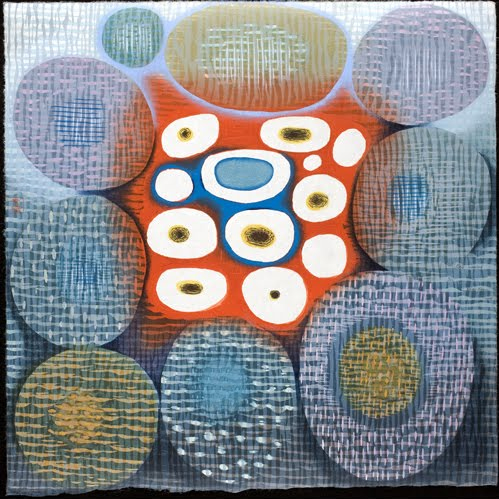Women's History Month 2011 I
Let’s kick off Women’s History Month by celebrating women printmakers. I’m a big fan of contemporary printmaking and how artists push the boundaries of the medium, especially since my only credentials in printmaking are from high school art classes.
When one looks at the history of printmaking, one sees an ebb and flow in its popularity. From the 1400s to the 1700s, printmaking was a major art form, appreciated not only for the nuances of tone and form, but also because the fine lines made with the tools allowed artists to produced fantastically detail masterworks of the past. In the 1800s, Mary Cassatt (1844–1926) was a pioneer in printmaking when the field was dominated by men. The revival of printmaking had begun in the 1850s and is a strong fine art medium on its own ever since.
 |
| Karen Kunc (born 1952, US), Orb Weaving, 2008. Color woodcut, 18 ¾" x 18" x 34" (46.5 x 46.3 cm). Worcester Art Museum, Worcester, MA. © 2011 Karen Kunc. (WAM-776) |
Woodcut is part of the oldest technique of printmaking, known as relief. The artist gouges out areas of the surface, leaving only the design to be printed elevated. Ink is spread over the raised sections of the block and transferred to paper by pressure. Other forms of relief printing are linoleum cut and wood engraving.
Karen Kunc follows a long line of successful women artists who work primarily in the field of printmaking. Starting in the early 1900s, women such as Mary Cassatt, Käthe Kollwitz, Mabel Dwight, Isabel Bishop, Kyra Markham, Adja Yunkers, and Kiki Smith have kept the art form a vibrant component of contemporary art in the 1900s and 2000s. Kunc received her BFA from the University of Nebraska-Lincoln and her MFA from Ohio State University. She is a professor at the University of Nebraska-Lincoln. She is best known for her large-scale abstract woodcut prints, and has paralleled that with an exploration of dynamic printed three-dimensional book forms.
Kunc's sophisticated work reminds me of everything from Bauhaus graphic artists (such as Herbert Bayer) to contemporary Latina artist Beatriz Milhazes. Here is Kunc's statement from her website about her work:
My work as an artist/printmaker addresses issues of the landscape and our natural surroundings as direct influences from my Nebraska heritage, my daily experiences and viewpoints in the landscape of the plains and from extensive travel, and as artistic interpretation and contemplation on larger issues of the eternal life struggle, of endurance and vulnerability, growth and destruction.
My prints suggest extremes of weather and natural forces at work, a sense of the micro/macrocosm, set against landscape or space, both wild and cultivated, intimate and unknowable. I am interested in the span of time it takes to wear away a canyon, build a mountain, the erosion forces that continually wash onto the plains, forming the earth, and, ultimately, shaping our world. My hope is that these larger concepts are provoked by viewing my work with a poetic and intelligent sense of wonder.
My symbolic images are derived from a rich mix of instilled influences, born at home, and greatly expanded and contextualized from seeing life lived the world over, my experiences and past work, and issues in contemporary art. I recognize a host of associations that flow out of my work and are research interests for me - from nature and science, spiritual and religious thought, art historical and modern icons, immigration narratives and native myths.
Correlations to Davis programs: Explorations in Art Grade 4: 6.35, A Community Connection: 8.2, A Global Pursuit: 9.1, The Visual Experience: 9.4, Discovering Art History: 17.6


Comments